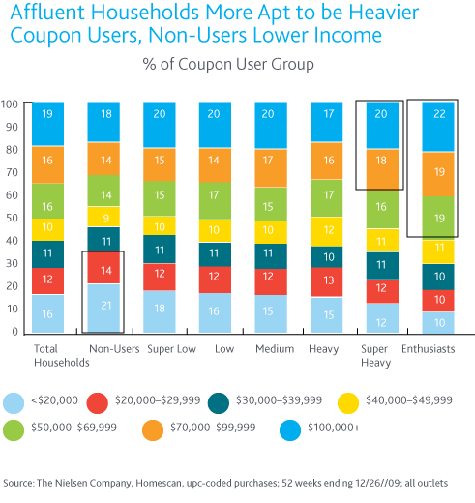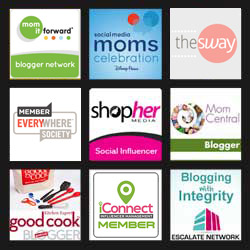 Nielsen recently released a report entitled “The Coupon Comeback,” which provides in-depth statistics as to who’s using coupons. Some highlights:
Nielsen recently released a report entitled “The Coupon Comeback,” which provides in-depth statistics as to who’s using coupons. Some highlights:
The “Great Recession” of 2009 changed all of that and marked a sort of renaissance for the coupon. Inmar reports that coupon redemptions grew by 27% as Americans searched for ways to cut household costs and get more for their money. NCH Marketing Services claimed 2009 coupon redemption levels “achieved the second highest year-over-year growth ever recorded.”
Coupon enthusiasts — the heaviest users — accounted for 65% of manufacturer coupon unit purchases and 18% of all unit purchases in 2009. They drove a disproportionate amount of sales and sales growth—shopping more frequently, making 1.7 more trips than non-users and buying more (a rate 1.8 times greater annually). While some might think that “crazed coupon clippers” are only interested in a good deal, these findings suggests real benefits to manufacturers and retailers deploying coupons in their marketing mix.
With the value offered by coupons, one might think that the lowest income households would be among the heaviest users. In fact, more affluent households dominate coupon usage: 38% of “super heavy” users and 41% of “enthusiasts” come from households with incomes greater than $70,000. Households with income of $100,000 and up were the primary drivers of coupon growth in 2009. The enthusiast category also attracts a disporportionate number of households with incomes between $50,000 and $69,900.
As the economy improves, will consumers continue to use coupons? With the economic recovery taking hold slowly and without significant employment growth, expect coupon use to continue. As long as Americans feel unsure about their personal finances or confident about their jobs, they are going to continue to look at ways to save and get the most for their money. In addition to expanding the appeal of coupons in general, manufacturers and retailers would do well to target enthusiasts: their shopping behaviors and demographics make them extremely appealing.
I really like the last paragraph here — we “crazed coupon clippers” indeed do affect the bottom lines for the manufacturers of the products that we buy, and we are an appealing group to attract. We buy a lot, we buy in quantity, and we visit the store often.
Many people are surprised by the financial demographics of coupon users too — it’s a common misconception that all coupon clippers must be poor or struggling financially. As the stats show, most coupon clippers are not only in the upper middle class demographic, they’re intelligent, smart, and savvy with their money.










crazyforcoupons says
So true–if you want to be a millionaire, don’t spend like one.
J.R. says
Those that have money have it because they spend less than they make. One good way to spend less is coupons, sales, etc.
And in the past few years a lot of those high income folks saw their income levels drop. I know our family income peaked in 2006 and still hasn’t recovered. One of the reasons we’ve increased our coupon usage.
dac says
Good stuff, thank you. I found it most interesting that Enthusiasts accounted for 65% of manufacturing coupons! I wonder if there is a newer version of this study…
dac